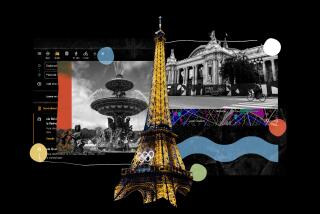Sharing some of her Paris secrets
- Share via
Paris — Paris is generous. Its treasures are arrayed along the River Seine for everyone to see. But the longer you stay, the more you find: secret gardens, restaurants only locals know, exquisite buildings far from the Champs Elysees.
I have been here for four months and have a growing list of favorites, which, in the spirit of Paris, I’m delighted to share:
* You would be unlikely to find Recamier square on the Left Bank if you didn’t know it was there, tucked at the end of the little Rue Recamier off Rue de Sevres near the Bon Marche department store. It sits in a quiet cul-de-sac surrounded by Paris apartments, geraniums spilling from their balconies. There are flower gardens, a waterfall, tall trees and barefoot children at play in the sandbox.
* Get a picnic lunch at Le Grand Epicerie, the huge gourmet supermarket on the first floor of Bon Marche. Or sit in the square for a spell and then have lunch at La Cigale Recamier, 4 Rue Recamier, 011-33-1-45-48-86-58. It has umbrella tables on the sidewalk and the best souffles in town -- spinach and Parmesan, crab, strawberry, chocolate -- for $11 to $18.
* The Musee Guimet on Place d’Iena is Paris’ serene Asian art museum, less crowded than the Musee d’Orsay or Louvre and renovated four years ago. It was founded in 1889 by industrialist Emile Guimet and is now a national museum with a collection that has art from China, India, the Himalayas, Southeast Asia, Korea and Japan (including 19th century woodblock prints by Hiroshige that inspired the French Impressionists).
Most breathtaking are objets d’art from early 20th century French archeological digs in Afghanistan and Pakistan. There’s a 1st century to 3rd century statue of a bodhisattva in the Greco-Buddhist style developed in the Gandara region of Pakistan after the arrival of Alexander the Great, and a Buddhist stupa, unearthed in 1927 at Tapa-Kalan monastery in Hadda, Afghanistan. In recent years art from these places has been subject to the ravages of war and despoliation, which makes these pieces all the more precious.
* You can buy a silver model of the Eiffel Tower or a reproduction Belle Epoque poster at any touristy shop on the Rue de Rivoli. But there could be no more perfect or distinctive Paris souvenir than a white cotton handkerchief with the Arc de Triomphe embroidered on the corner from D. Porthault, the city’s premier linen store.
Just browsing at Porthault, 011-33-1-47-20-75-25, at 18 Avenue Montaigne across from the Hotel Plaza Athenee, is delirium for the linen enthusiast. Exquisite sheets, nightgowns, coverlets, tablecloths and cocktail napkins make you want to get engaged, just so you can sign up for the bridal registry. You could choose linen for a new home at Porthault, as Jackie Kennedy did when she moved into the White House. Or buy a cotton hankie (about $20) and dream.
* Shortly after moving here, I wrote a story on budget restaurants in Paris for the Travel section. I missed a great one: Le Pre Verre, 8 Rue Thenard, 011-33-1-43-54-59-47, on the Left Bank near the Sorbonne. It’s nothing much in terms of atmosphere, cramped and a little smoky. But the food is amazingly sophisticated for the price: appetizers, $10; entrees, $18; desserts, $6.
Chef Philippe Delacourcelle, who opened Le Pre Verre a year and a half ago, suggests a starter of cold, creamy lemon soup. I’d follow that up with my favorite entree, suckling pig, served in a mildly spiced broth with crispy cabbage. There’s a prix fixe lunch: appetizer, main course, a glass of wine and coffee for $14. Talk about a square meal deal.
* I’d been to the lovely Place des Vosges in the heart of the Marais many times before discovering the Hotel de Sully. Its mellow classical facade fronts the busy commercial Rue St. Antoine, near the St. Paul Metro stop. It was built in 1624 and elaborated upon by the dukes of Sully throughout the 17th century and became the French Ministry of Culture and Communication’s National Monuments Center in 2000. The center’s information office, to the right of the grand main gate, provides pamphlets on several historic buildings and sites in Paris; through the paved central courtyard on the left is the center’s excellent bookshop. Occasionally there are exhibitions inside: When I was there in the spring, there was a startling collection of photos from the French-Algerian War, which ended in 1962
In the garden beyond the central courtyard, all geometrically clipped shrubs bounded by a graceful orangery, is the real glory of the Hotel de Sully. And then there’s the secret passageway on the right side of the garden, emerging directly into the Place des Vosges.
* Bercy, on the southeast side of Paris, looking over the Seine, was once the city’s wine entrepot. Now it’s reached by the new, fully automated Metro 14, which goes from Chatelet/Les Halles to Bercy in minutes. Many of the old wine warehouses there have been converted into shops and restaurants, surrounded by some of Paris’ most stunning modern buildings. Chief among them is the former American Cultural Center, designed by Frank O. Gehry in 1992. Now being transformed into a film museum, the free-form building is a clear precursor to Gehry’s Guggenheim Museum in Bilbao, Spain, and the Disney Concert Hall.
Bercy Park, a modernistic greensward with vintage trees, runs between the Bercy and Cour St. Emilion Metro stops. Its Garden House offers popular courses for amateur horticulturalists.
Read Susan Spano’s “Postcards From Paris” at www.latimes.com/susanspano. You may e-mail her at postcards@latimes.com. She regrets she cannot respond individually.
More to Read
Sign up for The Wild
We’ll help you find the best places to hike, bike and run, as well as the perfect silent spots for meditation and yoga.
You may occasionally receive promotional content from the Los Angeles Times.






